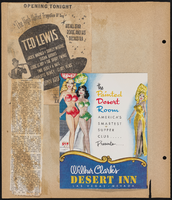Search the Special Collections and Archives Portal
Search Results

Transcript of interview with Marjorie Barrick by Mary Beth Nitzchke, March 13, 1981
Date
Archival Collection
Description
Text
Helen Jensen, Esther Faircloth, and Helen Rosati oral history interview
Identifier
Abstract
Oral history interview with Helen Jensen, Esther Faircloth, and Helen Rosati conducted by Claytee D. White on October 25, 2005 for the UNLV University Libraries Oral History Collection. In this interview, Jensen discusses her early life and arriving to Las Vegas, Nevada in 1923. She remembers the city at the time, Fremont Street, and the increase in population through the 1930s. Jensen talks about the construction of the Hoover Dam (Boulder Dam) and the legalization of gambling in 1931. Then, Faircloth and Rosati describe growing up in North Las Vegas and recreational activities they participated in. Lastly, Jensen, Faircloth, and Rosati recall the Helldorado parade, rodeos, and changes in Las Vegas.
Archival Collection
Marsha Lamb Bingham oral history interview
Identifier
Abstract
Oral history interview with Marsha Lamb Bingham conducted by Ted R. Murray on March 02, 1981 for the Ralph Roske Oral History Project on Early Las Vegas. During the interview Bingham discusses school in Alamo, Nevada, general Nevada history, Warm Springs, Nevada Legislature, Fremont, gambling, and the University of Nevada, Las Vegas (UNLV). Bingham also discusses the growth of Las Vegas, Nevada in the 1950’s and 1960’s, the Rock and Roll scene, and President Kennedy’s Las Vegas visit.
Archival Collection
Harrie Fox Hess oral history interview
Identifier
Abstract
Oral history interview with Harrie Fox Hess conducted by Scot Siegel on February 26, 1979 for the Ralph Roske Oral History Project on Early Las Vegas. Hess discusses how he felt as a young adult moving to Las Vegas, Nevada, his contributions to Nevada through his work as a psychologist, and the first law to be drafted on psychology certification in Nevada. Hess then describes the Wildcat Lair as an important site of social recreation for early Las Vegas youth. He also discusses how workers from the Great Depression paved the way for industrial success in gambling due to their employment on the Boulder (Hoover) Dam.
Archival Collection

Lederer cartoon: postcard
Date
Archival Collection
Description
Image
"Geraldo Rivera: Las Vegas, the American Fantasy": video, 2000 July 30
Level of Description
Scope and Contents
"Geraldo" talkshow episode "Las Vegas: the American Fantasy." Geraldo reports on the latest generation gambling in and on Las Vegas. Las Vegas is the fastest growing city in America in the year 2000. It is a unique fantasy in the desert drawing millions of tourists each year and is a major resource for employment. Corporate America has moved into Las Vegas and created super casinos and some of the largest hotels in the world. Since the arrival of super casinos, union membership has tripled, making Vegas one of the few places in the country where union membership is on the rise. The payoff for these workers is affordable housing and benefits that have changed the ethnic landscape of the city. Rivera also reports on gamblers with dreams of striking it rich and problem gamblers whose livers were torn apart because of their addiction. Original media VHS, color, aspect ratio 4 x 3, frame size 720 x 486.
Archival Collection
Collection Name: Stardust Resort and Casino Records
Box/Folder: Digital File 00, Box 026
Archival Component

Transcript of interview with Helen M. Baucum by William D. Marshall, February 28, 1975
Date
Archival Collection
Description
Text
John Archer Galley Notes for "The Archer Method of Winning at Blackjack"
Identifier
Abstract
The collection consists of one spiral bound copy of galley notes for John Archer's book, "The Archer Method of Winning at Blackjack," published in 1973.
Archival Collection


